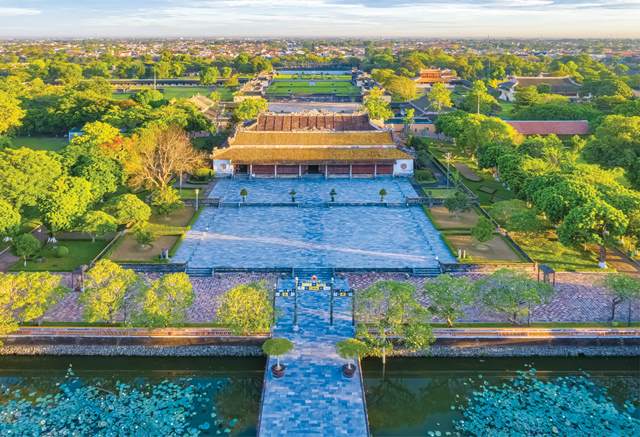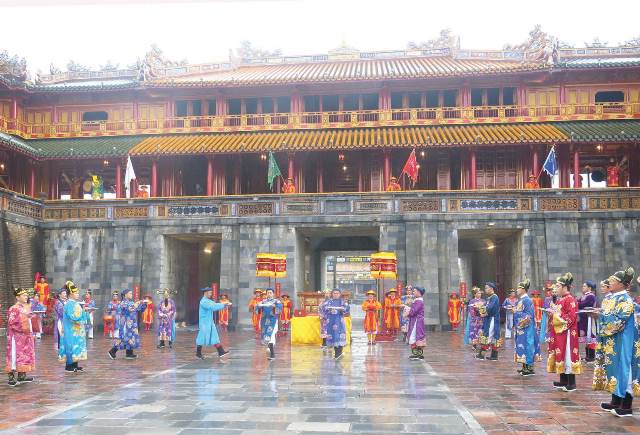
Mr. Hoang Viet Trung, Director of Hue Monuments Conservation Center
Receiving the investment in restoring and preserving for a long time, the Complex of Hue Monuments has passed the stage of emergency rescue and is gradually reviving the original appearance of a historic ancient capital. How has the restoration and preservation of heritage been paid attention, sir?
After the war, the Complex of Hue Monuments was severely damaged, with only more than 400 damaged and ruined works being existent (as compared to the original 1,400 works). Intangible heritages were also destroyed or scattered, whereas the system of royal festivals no longer existed after the end of the Nguyen Dynasty, etc.
With the attention of the Party and State, the Ministry of Culture, Sports and Tourism as well as the provincial leaders, the conservation of Hue Monuments has been implemented, and great results have been achieved. These important achievements are demonstrated in the following aspects: the conservation and restoration of monuments, the preservation of intangible culture, the preservation and embellishment of the landscape and environment of the heritage zones, the international cooperation, and the promotion of heritage values, etc.
Many small and large monuments have been restored and preserved, typically Ngo Mon (Noon gate), Hien Lam Pavilion, The Mieu relic complex, Dien Tho Palace, Duyet Thi Duong (Royal theater), Truong Sanh Palace, the system of tombs, etc.
The preservation and promotion of heritage values through many stages and periods are of great interest to the province and considered as a mission. Thua Thien Hue is judged by UNESCO as the leading locality in Vietnam in terms of heritage conservation.
According to UNESCO's assessment, the conservation of Hue monuments is currently transitioning to a stage of stability and sustainable development. Along with the restoration and preservation of heritage, we have also established a heritage management system and gradually raised people's awareness to join hands to protect the heritage.
However, the investment resources only meet a small part as compared to the vast number of monuments.
How is the current need for investment in restoration and preservation of heritage?
The need for investment in this practice is very great. In the period of 1996-2020, the total investment capital for conservation and restoration of relics is about 1,900 billion VND. In the period of 2021-2025, the planned investment capital is only about 1,000 billion VND for 5 years.
Although the central and local governments are very concerned, the needs of heritage restoration have not been satisfied yet. Investment resources for this practice are still limited and only partially met at the moment.
In the practice of restoration, therefore, based on the ability to balance resources, priority should be given to seriously degraded relics with special values. In the next period, Hue Monuments Conservation Center will restore Thai Hoa Palace, Can Chanh Palace, Kien Trung Palace, tombs, Thuong Thanh (Upper-surface Wall) system, the Protecting Trench system, etc.
Does the lack of resources make the conservation of heritage difficult?
We want to restore many buildings that have been seriously degraded, but the lack of funds causes us to endure or only resist acute deterioration. For example, despite having been degraded for many years, Thai Hoa Palace only got treatment for termites and leaks. Not until now does it receive enough expense for restoration. Many other buildings are in the same situation.

In the near future, more relics will be restored thanks to Hue Heritage Conservation Fund. Photo by Nguyen Phong
Unlike ordinary civil works, a relic restoration project requires a very elaborate preparation time, from research, data collection, archeology, situation assessment to project planning, design, etc., with many procedures from central to local. Therefore, if there are enough resources, the investment preparation phase can be conducted proactively and ready to be deployed when the capital is available. The concentration of resources will shorten the implementation time, overcoming the situation of spreading capital for many years.
In your opinion, how will the National Assembly’s permission to establish Hue Heritage Conservation Fund help in the restoration and preservation of heritage?
The Complex of Hue Monuments is not only the heritage of Thua Thien Hue, but the heritage of the whole nation as well. In the past, many localities witnessing the degraded relics when visiting Hue lamented and offered to support. However, the Budget Law did not allow the use of the local budget to support other localities.
The National Assembly's permission to establish Hue Heritage Conservation Fund will address this issue, adding resources to serve the restoration and preservation of cultural heritage and greatly supporting the preservation of tangible and intangible heritage in the province.
Hue Heritage Conservation Fund is entitled to receive state budget from supporting provinces and cities, funding from domestic and foreign organizations and individuals as well as other lawful sources. The fund's revenue is used to invest in the restoration, preservation, and development of Hue heritage values as well as works and items that have not yet or insufficiently received investment from the State budget.
In addition, the entrance fees to the monuments after deducting the expenses are appropriated for the Center to cover operating costs, whereas the local budget is allocated to invest in proportion to the amount of entrance fees paid into the State budget to make investment in the restoration of heritage. It is hoped that the specific mechanism for Thua Thien Hue, which has just been promulgated by the National Assembly, will contribute significantly to the preservation and protection of heritage.
In addition to restoring the heritage, many people hope that the Hue Heritage Conservation Fund will also make way for the repatriation of antiques when many valuable Nguyen Dynasty antiques are sold abroad but we do not have enough resources?
The issue of buying antiques abroad has been raised by many people. However, there are many legal issues involved when using the budget to buy antiques. The value of antiques is difficult to determine through pictures, especially those sold at auctions. The price is also inflated to many times as compared to the true value of the artifact.

The appearance of Hue heritage is gradually being revived
However, the support fund can be used to buy antiquities with complete legal records, clear origins, and appraisals of value and price. Previously, some collectors in Hue wanted to sell antiques to the Hue Monuments Conservation Center, but this was not possible due to lack of preparation of resources and legal procedures. Hopefully, Hue Heritage Conservation Fund will support these practices.
How does Hue Monuments Conservation Center want the Fund to be operated to create favorable conditions for the conservation of heritage?
Hue Monuments Conservation Center hopes that many benevolent localities, organizations, and individuals will pay attention to supporting, contributing, and joining hands in preserving and promoting heritage values. This is a national fund established by the Government and assigned to the province to directly manage, so localities, organizations and individuals that donate can be completely assured because the Fund operates based on a Decree issued by the Government, which clearly stipulates the financial mechanism, the organizational structure, and the operating regulations. All are controlled like the State budget.
Hue Monuments Conservation Center will also mobilize organizations and individuals to donate to the Fund through cooperation and external relations, while at the same time sharing and providing information for people to understand more about the values of Hue heritage so that they can contribute resources and join hands to preserve the heritage and cultural values passed down from our ancestors.
Thank you, Sir!
By Minh Hien
